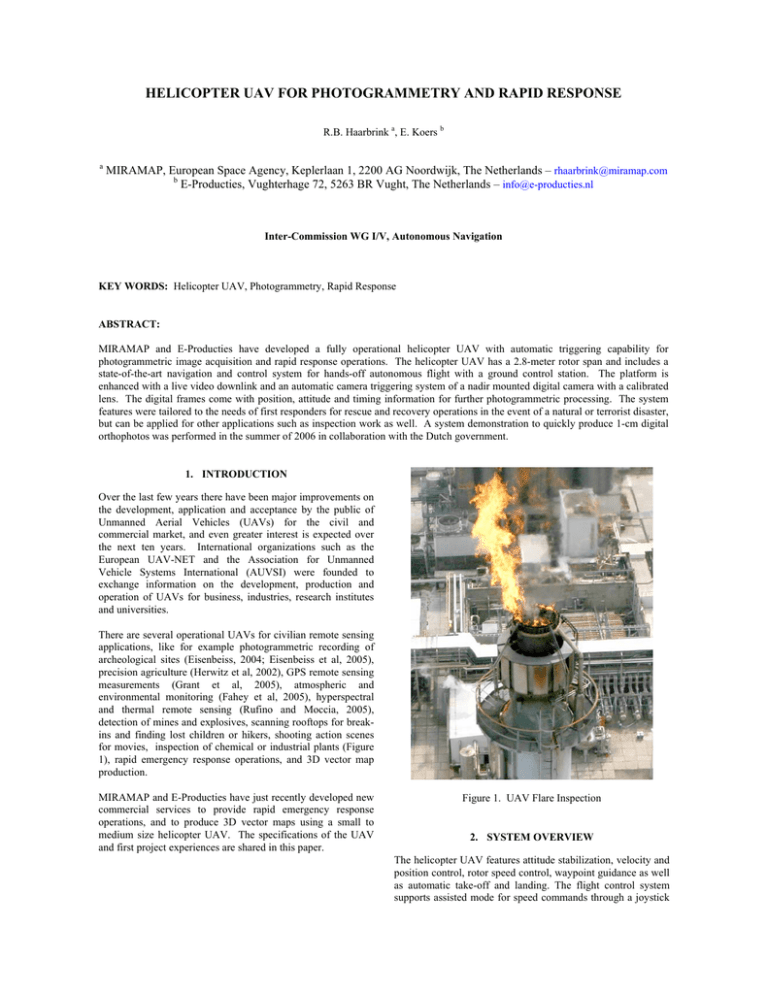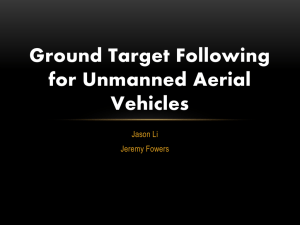HELICOPTER UAV FOR PHOTOGRAMMETRY AND RAPID RESPONSE
advertisement

HELICOPTER UAV FOR PHOTOGRAMMETRY AND RAPID RESPONSE R.B. Haarbrink a, E. Koers b a MIRAMAP, European Space Agency, Keplerlaan 1, 2200 AG Noordwijk, The Netherlands – rhaarbrink@miramap.com b E-Producties, Vughterhage 72, 5263 BR Vught, The Netherlands – info@e-producties.nl Inter-Commission WG I/V, Autonomous Navigation KEY WORDS: Helicopter UAV, Photogrammetry, Rapid Response ABSTRACT: MIRAMAP and E-Producties have developed a fully operational helicopter UAV with automatic triggering capability for photogrammetric image acquisition and rapid response operations. The helicopter UAV has a 2.8-meter rotor span and includes a state-of-the-art navigation and control system for hands-off autonomous flight with a ground control station. The platform is enhanced with a live video downlink and an automatic camera triggering system of a nadir mounted digital camera with a calibrated lens. The digital frames come with position, attitude and timing information for further photogrammetric processing. The system features were tailored to the needs of first responders for rescue and recovery operations in the event of a natural or terrorist disaster, but can be applied for other applications such as inspection work as well. A system demonstration to quickly produce 1-cm digital orthophotos was performed in the summer of 2006 in collaboration with the Dutch government. 1. INTRODUCTION Over the last few years there have been major improvements on the development, application and acceptance by the public of Unmanned Aerial Vehicles (UAVs) for the civil and commercial market, and even greater interest is expected over the next ten years. International organizations such as the European UAV-NET and the Association for Unmanned Vehicle Systems International (AUVSI) were founded to exchange information on the development, production and operation of UAVs for business, industries, research institutes and universities. There are several operational UAVs for civilian remote sensing applications, like for example photogrammetric recording of archeological sites (Eisenbeiss, 2004; Eisenbeiss et al, 2005), precision agriculture (Herwitz et al, 2002), GPS remote sensing measurements (Grant et al, 2005), atmospheric and environmental monitoring (Fahey et al, 2005), hyperspectral and thermal remote sensing (Rufino and Moccia, 2005), detection of mines and explosives, scanning rooftops for breakins and finding lost children or hikers, shooting action scenes for movies, inspection of chemical or industrial plants (Figure 1), rapid emergency response operations, and 3D vector map production. MIRAMAP and E-Producties have just recently developed new commercial services to provide rapid emergency response operations, and to produce 3D vector maps using a small to medium size helicopter UAV. The specifications of the UAV and first project experiences are shared in this paper. Figure 1. UAV Flare Inspection 2. SYSTEM OVERVIEW The helicopter UAV features attitude stabilization, velocity and position control, rotor speed control, waypoint guidance as well as automatic take-off and landing. The flight control system supports assisted mode for speed commands through a joystick and mission mode for pre-programmed flight trajectory tracking. Figure 2 shows the helicopter UAV. Its performance specifications are listed in Table 1. A ground control station (Figure 3) shows on a flight control screen real-time flight data such as position, speed, attitude, distance, auto-pilot functionality, and several safety features, including status indicators of the serial data-link connection between ground station and aircraft, GPS solution validity, RC radio connection, voltage of power supply and RC receivers/servos, fuel level indicator, and rotor speed indicator. If the data-link integrity is lost, the helicopter UAV will automatically return to its home waypoint. A second screen shows real-time, color video images fed from above. 3. RAPID RESPONSE OPERATIONS Figure 2. Helicopter UAV after Take-Off Parameter Main rotor Tail rotor Height Fuselage length Electronic compartment Fuel tank MTO weight Empty weight Turbine Battery The system features were tailored to the needs of first responders for rescue and recovery operations in the event of a natural or terrorist disaster. To date in the Netherlands, never was taken advantage of real-time geo-information during or shortly after large scale disasters. Police helicopters in the Netherlands often broadcast live video footage of a disaster area, but these images are not geo-referenced thus cannot be combined with existing data, and therefore real-time data collection is not fully taken advantage of for effective response operations. Large scale disasters such as at the World Trade Center, the Tsunami and hurricane Katrina have proven the critical need for real-time collected geo-information to support these response operations. Value 2800 mm 530 mm 900 mm 2320 mm ± 250 x 250 x 500 mm 9,5 liter 35 kg ± 20 kg Jet Cat SPT5-H (6,5 kW) LIPO 11,1V 15AH Table 1. Specifications of the Helicopter UAV Figure 4. Part of Rapidly Produced 1-cm Orthophoto The system is quickly deployable, it collects real-time color and thermal infrared video imagery that is broadcasted directly to the command and control center, and it collects high resolution geo-referenced digital imagery (Figure 4) that is available to first responders on existing GIS platforms in open GIS formats within 1-2 hours after the disaster event has happened. Other than having the availability of existing data in a geospatial data warehouse before a disaster happens, it is critical to also have the availability of accurate and actual geo-information during and shortly after a disaster happens. This particular helicopter UAV system enables responders to quickly and safely collect geo-referenced data, and equally important, within budget. Figure 3. Ground Control Station A full system demonstration was given on June 10, 2006, at a large practice of fire fighters and medical troops of the Veiligheidsregio Noord- en Oost-Gelderland in the Netherlands. The system captured and broadcasted live video footage, and collected a block of digital imagery that was processed to a very detailed photo mosaic within the hour after flight. 4. PHOTOGRAMMETRY The helicopter UAV features mission mode for preprogrammed flight trajectory tracking that is combined with an automatic camera triggering system of a nadir mounted digital camera. The digital camera currently installed is a Fuji FinePix S3 Pro with a calibrated 28-mm lens. Each digital frame counts 12 Mega pixels and comes with position, attitude and timing information for further photogrammetric processing. The system enables collection, processing, and delivery of seamless high resolution orthophotos (Figure 5) and 3D vector maps to update existing databases. The benefits of this particular helicopter UAV over traditional aerial survey with large format cameras and/or terrestrial methodologies are its quick, safe and affordable map updates of areas with the size of a cross section or highway rest area. Figure 6. Typical Photogrammetric Flight Plan The photogrammetric products are generated in a digital workflow of triangulation, block adjustment, image matching and 3D stereo models. Currently, Ground Control Points (GCPs) are used to validate the GPS/IMU data of the system. The first results with an assessment of the product quality are expected to be presented at the workshop. 5. CONLUSIONS MIRAMAP and E-Producties have successfully developed and demonstrated a new helicopter UAV system for the civil market to provide rapid emergency response operations, and to produce photogrammetry products. The system enables first responders to have access to real-time color and thermal infrared video imagery broadcasted directly to the command and control center, and to high resolution georeferenced digital imagery that can be easily combined with existing geo-information databases. The system is also quick, safe and affordable to collect, process and deliver seamless high resolution orthophotos and 3D vector maps of areas with the size of a cross section or highway rest area. Figure 5. Seamless High Resolution Orthophoto Mosaic Typical photogrammetric flight parameters and a flight plan of a typical project area are shown in Table 2 and Figure 6. The flight plan is uploaded to the helicopter UAV that automatically follows the pre-determined trajectory and triggers the camera at the appropriate location. Parameter Flying height Side lap Forward lap Pixel Size Single photo coverage Value 100 m AGL 30% 60% 2 cm 80 by 60 m2 Table 2. Typical Photogrammetric Flight Parameters 6. REFERENCES Eisenbeiss, H., 2004. A mini unmanned aerial vehicle (UAV): system overview and image acquisition. International Archives of Photogrammetry, Remote Sensing and Spatial Information Sciences, vol. XXXVI-5/W1, on CD-ROM. Eisenbeiss, H., K. Lambers and M. Sauerbier, 2005. Photogrammetric recording of the archeoligical site of Pinchango Alto (Palpa, Peru) using a mini helicopter (UAV). International Archives of the Photogrammetry, Remote Sensing and Spatial Information Sciences, vol. XXXIV-5/C34, pp. 238243. Fahey, D.W., A.J. Gasiewski, M. Aslaksen, S. Summers, C.D. Jennison, N. Trongale, J.H. Churnside, J.W. Elkins, D.F. Hurst, T. Jacobs, M. Klein, S.J. Oltmans, B.W. Orr, J.D. Sellars, L.C. Freudinger, K. Dunwoody, K.H. Rosenlof and E. Ray, 2005. The NOAA Unmanned Aerial System (UAS) Demonstration Project Using the General Atomics Altair UAS. AIAA 20056923, Arlington, VA. Grant, M.S., S.J. Katzberg and R.W. Lawrence, 2005. GPS Remote Sensing Measurements Using Aerosonde UAV. AIAA 2005-7005, Arlington, VA. Herwitz, S.R., L.F. Johnson, R.G. Higgins, J.G. Leung and S.E. Dunagan, 2002. Precision agriculture as a commercial application for solar-powered unmanned aerial vehicles. AIAA 2002-3404, Portsmouth, VA. Rugino, G. and A. Moccia, 2005. Integrated VIS-NIR Hyperspectral / Thermal-IR Electro-Optical Payload System for a Mini-UAV. AIAA 2005-7009, Arlington, VA. 7. ACKNOWLEDGEMENTS The rapid response activities are supported by the Dutch subsidy program Ruimte voor Geo-Informatie (RGI). The authors would also like to thank Henri Eisenbeiss of the Institute of Geodesy and Photogrammetry, Swiss Federal Institute of Technology (ETH) for his scientific and practical input.



